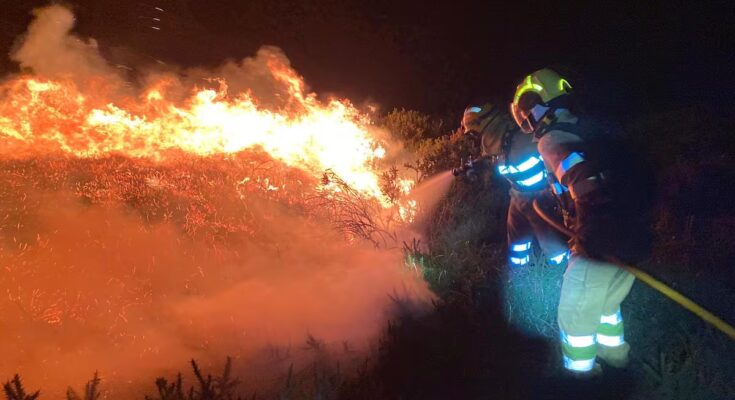Cantabria woke up this Thursday “on high alert”, according to the 112 emergency service, due to the high risk of fires due to high temperatures and intense southerly winds, circumstances of which the arsonists caused 20 forest fires last night. Of these, eight are controlled and six are still active, with firefighters deployed in various parts of the community. Sources close to members of the brigade and who know the rural environments in which these outbreaks occur explain that it is normal to suffer these waves of flames in autumn because farmers, knowing that there are these strong gusts of dry wind, set fire to the land to gain space for grazing.
This was reported by Cantabria 112 through its account on the social network. Furthermore, it underlined that the multiple outbreaks active at the same time are significantly complicating the extinction operations due to the high simultaneity, so much so that “the alert remains maximum for the next few hours, so the entire operation remains active”. The most complex points are found around Puente Viesgo, since the fire affects the CA-170 road, also around Peñas de Bejes “due to possible landslides in the La Hermida gorge” and a similar scenario in Proaño, where “fortunately the flames are moving away from the population centers” and do not present risks for the city despite starting close to its borders. The intense gusts of wind are feeding the fronts and inducing the displaced firefighters, faced with the high flames, to attack it from the tail while it is more difficult to hold it back from the front.
Of the 20 #IIFF provoked inside #Cantabria tonight, 8 are checked and 6 are active. The high simultaneity significantly complicated the extinction tasks. The alert remains maximum for the next few hours too, therefore @cantabriaes keeps the entire operation active. pic.twitter.com/VB9dnZIR9p
— 112Cantabria (@112Cantabria) November 13, 2025
The State Meteorological Agency (Aemet) reports that “today, Thursday, a very high level of fire danger is expected as the weather conditions are very adverse: very strong southerly wind gusts, very low relative humidity and temperatures above the usual values”, since in several parts of the region 25 degrees were exceeded and the minimum temperatures barely served to cool or moisten the fire areas. The storm Claudiawhich brought rain to the north-west, did not touch the territory of Cantabria and its waters and coolness are not expected to contribute to containing active or uncontrolled fires in the next few hours. Meanwhile, yellow and orange alerts continue in various sectors of the region, external and internal, due to winds of up to 110 kilometers per hour, allies of the fire to continue to favor it, also favored by the drought.
Sources close to the forest fire brigade and the inhabitants of the mountainous areas explain that it is common practice among farmers to take advantage of the hot days of October or November, with the countryside still very dry from the summer and without rain on the horizon, to carry out voluntary fires. In this way they can obtain land for livestock farming or agricultural practices.



